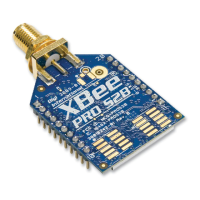Transmission, addressing, and routing Encrypted transmissions
XBee/XBee-PRO ZigBee RF Modules User Guide 67
Disabling MTO routing
To disable many-to-one (MTO) routing in a system where it has been active, you will need to disable AR on the
aggregator, and do a network wide power reset to rebuild the routing tables.
1 Set AR on the aggregator to 0xFF.
2 Do an AC command to enact the change.
3 Do a WR command if the saved configuration setting value for AR is not 0xFF.
4 Broadcast a FR remote command and wait for the network to reform.
This ends the aggregator's periodic broadcast of routing messages if the previous setting was 0x01-0xFE. It also
prevents a single routing message broadcast after a power reset if the previous setting was 0x00. Broadcasting
the FR (reset) remote command to the network removes the aggregator's status as an aggregator from the
network's routing tables so that no more route records will be sent to the aggregator.
Encrypted transmissions
Encrypted transmissions are routed similar to non-encrypted transmissions with one exception. As an encrypted
packet propagates from one device to another, each device decrypts the packet using the network key, and
authenticates the packet by verifying packet integrity. It then re-encrypts the packet with its own source address
and frame counter values, and sends the message to the next hop. This process adds some overhead latency to
unicast transmissions, but it helps prevent replay attacks. See ZB security on page 74 for details.
Maximum RF payload size
XBee ZB firmware includes a command (ATNP) that returns the maximum number of RF payload bytes that can
be sent in a unicast transmission. Querying the NP command, like most other commands, returns a
HEXADECIMAL value. This number will change based on whether security is enabled or not. If security is enabled
(EE command), the maximum number of RF payload bytes decreases since security requires additional overhead.
After reading the NP value, the following conditions can affect the maximum number of data bytes in a single RF
transmission:
Broadcast transmissions can support 8 bytes more than unicast transmissions.
If source routing is used, the 16-bit addresses in the source route are inserted into the RF payload space. For
example, if NP returns 84 bytes, and a source route must traverse three intermediate hops (3 16-bit
addresses), the total number of bytes that can be sent in one RF packet is 78.
Enabling APS encryption (API TX option bit set) will reduce the number of payload bytes by 4.
Note Broadcast transmissions do not support fragmentation. Maximum payload size = 84 bytes.

